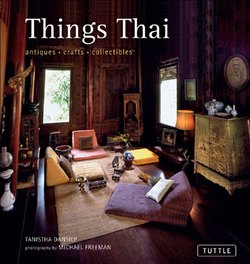Читать книгу Things Thai - Tanistha Dansilp - Страница 7
На сайте Литреса книга снята с продажи.
ОглавлениеForeword
One of the clearest, if not the prettiest, views of Bangkok is from the elevated expressway entering the city from the airport. From here, you can see the archetypal modern Southeast Asian city—office blocks, apartment buildings, hotels and a malaise of grandiose high-rise ‘statements’, all air-conditioned, all imported in style, all depressingly familiar. The bustle and energy are certainly here, but is this really the face of Thai culture?
But take a closer look at the passing cityscape (much easier when the traffic slows to a crawl at one of the freeway exits). Between the modern buildings are occasional glimpses of something different—a flash of sunlight on gold from a delicate spire in the grounds of a temple, a strange but elegant wooden roof, a narrow lane lined with food vendors and a woman swaying under the load of two wicker pannier baskets. Tucked away throughout Bangkok are warrens of these lanes, virtual villages in the city. Being where they are, these communities are perhaps not quite as neat and tidy as their counterparts in the countryside, but they contain much of the same traditions.
The fact is that Thailand is still exceptionally rural. Despite the migration to the cities, most Thais live in hamlets, villages and small towns, and this is where the culture has changed least. It is also where we must look to find most of the artefacts that reflect this culture. And they certainly are there to be found—a wealth of ‘things Thai’ that are unique, still in production, and still being used in daily life. The water dipper, rice basket, farmer’s hat, coconut scraper and the tube skirt are all products of the country’s strong tradition of village crafts.
Enter any Thai monastery—easy to find, there are more than 30,000—and you find yet another world, full of distinctive Buddhist iconography represented in carvings, bronze castings, mural paintings and innumerable crafted offerings. More surprisingly perhaps, for a foreign visitor, is that these monasteries are so alive, not just with their community of monks, but as active places of worship and meditation for the laity. There are hardly any monasteries that are not an integral part of the normal daily life of the village or town.
Back in Bangkok, in and around the original heart of the city known as Rattanakosin Island (actually separated only by canals), you find a third area of Thai culture—that surrounding the royal court. This too is distinguished by its artefacts and its crafts, more refined, more accomplished and more costly than those of the country and the monastery, yet related to both aesthetically. The Grand Palace and the sacred complex of Wat Phra Kaeo (the Temple of the Emerald Buddha) within its precincts is an exemplar of high Thai art. In the past, the best artisans were recruited to work for the palace and for the nobility, and they evolved a refined and highly decorative art in several different fields—mother-of-pearl inlay, gold-resist lacquerwork, ceramics, and many more.
However, this decorative tradition, which makes up so much of Thai artistic expression, would not have survived naturally to the extent that it has without positive support and nurturing. This occurred under various rulers, and continues to this day. Thais value their cultural heritage as much as they do their sense of national identity. Many writers, both Thai and foreign, have tried to get to grips with the concept of Thai-ness, a concept that is elusive in definition. Perhaps it even resists precise definition in words. An alternative approach, and the stimulus for this book, is to look at how Thai-ness expresses itself through its artefacts. The things Thai that follow are an oblique approach to understanding something of the national character. This selection that we have chosen, from the everyday to those conceived for special purposes, can, we believe, give a more eloquent picture of Thai culture.
